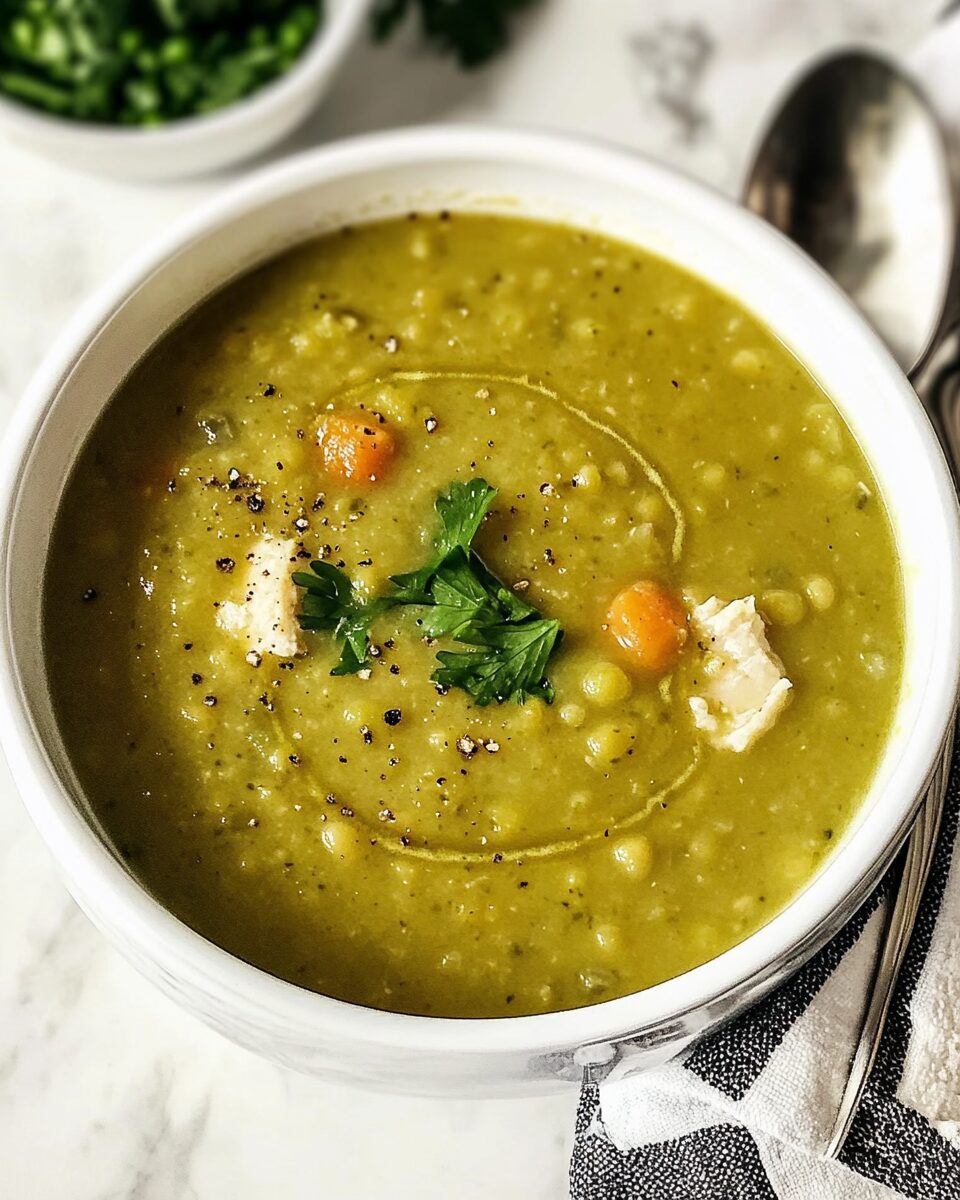This split pea soup is a classic, hearty, and comforting dish, perfect for using up leftover ham bones from holiday meals. The recipe features dried split peas, mirepoix vegetables (onion, carrots, and celery), and a meaty ham bone for deep flavor. It simmers for about an hour, thickening into a satisfying, nutrient-dense soup. The recipe is budget-friendly, rich in protein and fiber, and can be adjusted for different dietary preferences, including vegetarian options.
Full Recipe:
Ingredients
-
Dried Split Peas (green for sweetness, yellow for earthiness)
-
Vegetables (onion, carrots, celery, garlic)
-
Ham Options: Ham bone (preferred), ham hock, ham steak, bacon, or pancetta
-
Herbs & Seasoning: Thyme, bay leaf, salt, pepper
-
Soup Base: Chicken broth and water
Cooking Instructions
-
Sauté Vegetables – Cook onions, carrots, and celery in olive oil, then add garlic.
-
Add Peas & Seasoning – Stir in split peas, thyme, salt, and pepper.
-
Simmer the Soup – Add the ham bone, bay leaf, broth, and water. Cover and cook for 50-60 minutes, stirring occasionally.
-
Finish & Serve – Remove the ham bone, chop the remaining meat, and return it to the soup. Simmer uncovered for another 5-15 minutes until the desired thickness is reached.
Storage Tips
-
Refrigerate: Store in an airtight container for 4-5 days. Add water when reheating as it thickens.
-
Freeze: Lasts up to 3 months in freezer-safe containers.
Variations & Substitutes
-
No Ham Bone? Use a ham hock, diced ham steak, or crispy bacon.
-
Vegetarian Option: Skip the ham and use vegetable broth instead.
Classic Split Pea Soup: A Hearty and Comforting Dish
Split pea soup is a beloved comfort food that has stood the test of time. Known for its thick, hearty texture and rich, smoky flavor, this soup is a staple in many households, especially during the colder months. It is traditionally made with dried split peas, aromatic vegetables, and a meaty ham bone, which infuses the broth with deep, savory notes. Whether enjoyed as a wholesome meal on its own or served with a side of crusty bread, split pea soup is both nourishing and budget friendly.
In this article, we will explore the history of split pea soup, its health benefits, and various ways to customize the recipe to suit different dietary preferences. Whether you are a seasoned cook or a beginner in the kitchen, this soup is easy to prepare and perfect for batch cooking, making it an ideal addition to your meal rotation.
A Brief History of Split Pea Soup
Split pea soup has roots in many different cultures and has been enjoyed for centuries. The origins of this dish can be traced back to ancient Greece and Rome, where peas were a common ingredient in soups and stews. In medieval Europe, split pea soup became a staple among peasants due to its affordability and long shelf life. The ability to dry and store peas made them an essential food source, particularly during the winter months when fresh vegetables were scarce.
In North America, split pea soup gained popularity through European settlers, particularly in regions with strong Dutch, Scandinavian, and French influences. One of the most well known variations of split pea soup comes from Canada, where “Habitant Pea Soup” is a traditional dish dating back to the 1600s, when French settlers made the soup using dried peas, salted pork, and root vegetables.
Another famous variation is Erwtensoep, or Dutch pea soup, which is thick and often served with smoked sausage. In Sweden and Finland, ärtsoppa is a common dish eaten on Thursdays, traditionally followed by pancakes for dessert. These different cultural adaptations highlight the versatility and enduring popularity of split pea soup around the world.
Why Split Pea Soup is a Must-Try Recipe
1. Comforting and Satisfying
Split pea soup is the definition of comfort food. Its thick, creamy consistency and rich, smoky flavor make it a perfect dish to warm up with on a cold day. The combination of split peas and slow-cooked ham creates a deeply satisfying meal that is both nourishing and filling.
2. Nutritious and Healthy
Beyond its comforting taste, split pea soup is packed with essential nutrients. Split peas are an excellent source of fiber, protein, and complex carbohydrates, making them a great plant-based protein option. They are also rich in vitamins and minerals, including iron, potassium, and B vitamins.
Additionally, this soup is low in fat and can be easily adapted to suit different dietary needs. Using a ham bone adds flavor and protein, but a vegetarian version with vegetable broth and additional herbs can be just as delicious and nutritious.
3. Budget-Friendly and Practical
One of the best things about split pea soup is its affordability. Dried split peas are inexpensive and have a long shelf life, making them a pantry staple. The soup also makes excellent use of leftover ham bones, reducing food waste and adding incredible depth of flavor. For those looking to cook delicious meals on a budget, this soup is a fantastic option.
4. Easy to Prepare and Perfect for Meal Prep
Split pea soup is a one-pot dish that requires minimal effort but delivers maximum flavor. Once the ingredients are combined, the soup simmers gently on the stove, allowing the flavors to develop over time. The result is a thick, hearty soup that improves in taste as it sits.
This makes it an ideal recipe for meal prep. It stores well in the refrigerator and can be frozen for up to three months, making it a great option for busy weeks when you need a quick, homemade meal.
Customizing Your Split Pea Soup
While the classic recipe calls for ham and a simple blend of vegetables, there are many ways to customize split pea soup based on your preferences and dietary needs.
1. Meat Options
-
Traditional Ham Bone: Adds a deep, smoky flavor and makes the soup heartier.
-
Ham Hock or Smoked Turkey Leg: Offers a similar flavor if you don’t have a ham bone.
-
Bacon or Pancetta: Adds a crispy, smoky element when sautéed with the vegetables.
-
Vegetarian Version: Skip the meat and use vegetable broth for a lighter but still flavorful soup.
2. Additional Vegetables
-
Leeks or Shallots: For a more delicate onion flavor.
-
Potatoes: Adds extra heartiness and makes the soup even creamier.
-
Spinach or Kale: Stir in leafy greens for added nutrition.
-
Bell Peppers or Tomatoes: For a slightly different depth of flavor.
3. Spices and Seasonings
-
Smoked Paprika: Enhances the smokiness of the soup.
-
Cumin or Coriander: Adds warmth and depth to the flavor profile.
-
Lemon Juice or Apple Cider Vinegar: A splash at the end brightens up the dish.
4. Texture Variations
-
For a chunky soup, simply stir and serve as is.
-
For a creamy texture, use an immersion blender to partially or fully purée the soup.
Serving Suggestions
Split pea soup is delicious on its own, but it pairs wonderfully with a variety of side dishes. Here are a few ideas to elevate your meal:
-
Crusty Bread: A fresh baguette or sourdough bread is perfect for dipping.
-
Cornbread: The slight sweetness of cornbread complements the smoky flavors of the soup.
-
Grilled Cheese: A gooey, melted cheese sandwich makes for a comforting pairing.
-
Side Salad: A light, refreshing salad with citrus vinaigrette balances out the richness of the soup.
Conclusion
Split pea soup is more than just a simple dish it’s a time honored comfort food that is packed with flavor, nutrition, and history. Its rich, hearty texture and versatile nature make it a perfect meal for any occasion, whether you’re looking to use up leftovers, cook on a budget, or prepare a nutritious, satisfying meal.
With the ability to customize the recipe to suit different tastes and dietary needs, split pea soup remains a beloved classic across generations and cultures. Whether you enjoy it as a hearty winter dish or a make ahead meal, this soup is sure to warm you up and keep you coming back for more.






